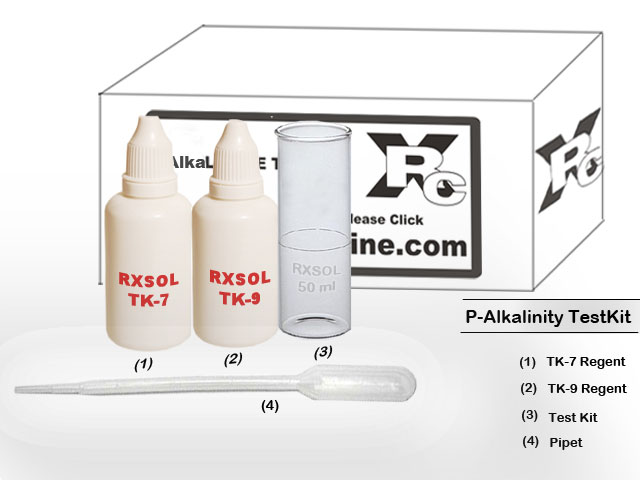Total Hardness Solution
To determine both the temporary and permanent hardness of the given sample of water
Water is turned out to be hard owing to the presence of calcium or magnesium bicarbonates and chlorides or sulphates of calcium or magnesium. Correspondingly they are known as temporary hardness and permanent hardness of water. Both temporary and permanent hardness of water are expressed as their equivalents of CaCO3 in parts per 1,00,000 parts of water. This is referred to as Degrees of Hardness of water. For example, if a sample of water contains 10 parts of CaCO3 in 1,00,000 parts of water, it is said to possess 10 Degrees of hardness.
Determination of Temporary Hardness
Temporary hardness of water is caused by the presence of bicarbonates of calcium or magnesium. Hence its amount is estimated by directly titrating with a standard solution of an acid.
Exactly 100 ml of the given sample of water is buretted out or pipetted out into clean conical flask. Two drops of methyl orange indicator are added to it and titrated against HCI acid from the burette. When the water turns to a pale pink colour, the addition is stopped and the reading is noted down. Another titration is conducted for concordancy.
Determination of Permanent Hardness
When a measured excess of standard sodium carbonate solution is mixed with a known volume of hard water, the calcium and magnesium salts are completely precipitated as their insoluble carbonates. After filtration, the unreacted sodium carbonate is determined by titrating against standard HCI using methyl orange as the indicator. From the volume of hydrochloric acid equivalent in alkali carbonate, the amount of hardness is calculated.
A 100 ml of the given sample of water is accurately measured out into a clean conical flask. It is boiled for half an hour. This removes the temporary hardness. To this water, a 10 ml of 0.1N Na2CO3 solution is added and boiled for an hour. The solution is cooled and a freshly prepared distilled water is added to make up the volume loss by evaporation. It is filtered through a filter paper and the filtrate is collected in a conical flask. Two drops of methyl orange indicator are added to the filtrate and titrated against the standard HCI taken in the burette, until the solution becomes of pale pink colour. A duplicate experiment is conducted. From the volume of HCI consumed, the permanent hardness of water is calculated.
(i) Temporary hardness of the given sample of water = ... degrees.
(i) Permanent hardness of the given sample of water = ... degrees. Calculation
Calculation
1. Temporary Hardness
CaCO3 + 2HCl >>>> >>>>>>>>>>>>CaCl2 + H2O + CO2
100 g of CaCO3 2,000 ml of 1N HCl
Titration value 3.2 ml of 0.1025N HCl
3.2 ml of 0.1025N HCl = 3.5 ml of 0.1N HCl
100 parts of the water required = 3.5 ml of 0.1N HCl
1,00, 000 parts of water will require 3.5 / 100 x 1,00,000 = 3500 ml of 0.1N HCl
1,00,000 parts of water will require = 350 ml of 1N HCl
As per the equation, 1 ml of 1N HCl = 0.05 g of CaCO3
1 ml of 0.1N HCl = 0.005 g of CaCO3
350 ml of 1N HCl = 350x0.05 g of CaCO3
=17.50 g of CaCO3
Degree of Temporary Hardness = 17.5 Degree
2. Permanent Hardness
Titration value = 7.3 ml of 0.1025N HCl
7.3 ml of 0.1025N HCl = 7.5 ml of 0.1N HCl
Volume of the water sample taken = 100 ml
Amount of Na2CO3 added = 10 ml of 0.10 N
Amount of Na2CO3 = 7.5 ml of 0.1N HCl
7.5 ml of 0.1N HCl = 7.5 ml of 0.1N Na2CO3
Amount of Na2CO3 reacted = 10 – 7.5
= 2.5 ml of 0.1N Na2CO3
= 2.5 ml of 0.1N HCl
1 ml of 1N HCl = 0.05 g of CaCO3
1 ml of 0.1N HCl = 0.005 g of CaCO3
2.5 ml of 0.1N HCl =0.005x25
= 0.0125 g of CaCO3
Amount of CaCO3 in 1,00,000 parts = ( 0.0125/100 ) 1,00,000
= 12.5 g
Permanent Hardness = 12.5 Dgree
Total Hardness = 17.5 +12.5 = 30 Degree
Test for Hardness of water:
Reagents: 0.01 M EDTA Buffer solution
Eriochrome Black T indicator
Standard EDTA solution
Disodium dihydrogen ethylenediamine tera acetate (A.R.) is available commercially and can be used as a primary standard. However, many samples contain moisture which is difficult to remove through drying. In such cases the solution is standardized against standard zinc or magnesium solution. Its molecular weight is 372.25 and after drying at 80oC it can be weighed out a accurately.
1.Eriochrome Black T: This substance is sodium (I-hydroxy-2- naphthylazo)-6-nitro-2-naphthol-4-sulphonate). It is also known as Solochrome black or WDFA. etc. In strongly acid solution Eriochrome Black T (EBT) polymerises to a red brown product, and the metal complexes are usually red in colour.
The colour at different pH given by Eriochrome black T are:
Red - below pH 5.5
Blue - between pH range 7-11
Yellowish orange - above pH 11.5
Between pH range 7-11, when metallic salts are added, the colour of the indicator changes from blue to red. At the end point in EDTA titration the indicator will be set free and colour change will be from red to blue.
Preparation of Eriochrome Black T as indicator
(i) the solution of indicator is prepared by dissolving 1 g of Eriochrome Black T in 15 ml of trienthanol amine and adding 5 ml of absoluta alcohol. It can also be prepared by dissolving 0.2 g of Eriochrome Black T in 20 ml of absolute alcohol. Use about 3 to 4 drops of the indicator solution.
(ii) 1 g of the indicator is grinded with 100 g of NaCl to a very fine powder. This mixture is stored in a well stoppered bottle. Use about 0.2 g of indicator in each titration.
Procedure:
. 20 drops of sample water was take in a dry test tube with a calibrated pipette.
. Adding 2 drops of butter solution to the tube.
. Adding a pinch of Eriochrome Black T indicator to the tube.
. Stir the solution. The colour of the solution will became wine red.
. Adding EDTA with another pipette till the colour changes to blue. . Counting the drops of EDTA.
Calculation:
Volume of EDTA = no. of drops of EDTA x drop value of pipette = V1 Molarity of EDTA = M1
Volume of water = no. of drops of water x drop value of water = V2 Hardness (mg/L) = V1 x M1 x 105/V2
Result: The hardness of sample water is ___________
To determine magnesium against EDTA using Eriochrome Black T as an indicator.
Material required
(i) 0.1 M EDTA solution: Dissolve 37.225 g of EDTA into 1000 ml of volumetric flask, in redistilled water and make upto the mark with the same water.
(ii) Eriochrome Black T (EBT) indicator solution.
(iii) Buffer solution (pH 10): Add 57 ml of concentrated ammonia solution (sp. gr. 0.88) to 7 g of NH4Cl (A.R.) and dilute to 100 ml with distilled water.
(iv) Magnesium ion solution (0.1M): Weigh accurately 0.61 g of magnesium turning and dissolve in HCl. Neutralise the resulting solution with M-sodium hydroxide. Transfer in to a 250 ml volumetric flask and dilute the solution with distilled water up to the mark. MgSO4.7H2O can be employed for preparing the solution. Weigh accurately 7.10 g magnesium sulphate heptahydrate and dissolve in water and dilute to 250 ml.
MgSO4 + Na2C10H14O8N2
MgC10H14O8N2 + Na2SO4
Procedure
Take 250 ml of the magnesium solution in a conical flask, dilute to about 100 ml with distilled water. Add 2 ml of the buffer solution (pH10). Add 4-5 drops of indicator solution and titrate against 0.1M EDTA solution with constant solution stirring until the colour changes from red to blue at the end point.
1 ml of 0.1M EDTA = 2.432 mg of Mg.
Precautions:
1. EDTA should be dried be remove moisture in the preparation of its solution.
2. Redistilled water should be employed for preparing the EDTA solution.
3. Polyvalent cations, if present, interfere and hence should be removed as hydroxides.
4. The colour change near the end point is very slow. Care should be taken to avoid over titration.
To determine calcium against EDTA using Murexide as an indicator. Materials required
(i) 0.01 M EDTA solution:
(ii) Murexide indicator solution:
(iii) NaOH solution: Prepare 1M aqueous solution.
(iv) Calcium ion solution (0.01 M): Weigh accurately 0.50 g A.R. CaCO3 and transfer the salt in a 500 ml measuring flask. Dissolve the salt in minimum quantity of 6M HCl adding drop by until effervescences stop and the solution become clear. Make up the mark.
Procedure
Talk 25 ml of the calcium solution, dilute to 100 ml with water and add 2 ml of 1 (M) NaOH solution to have a solution of pH about 12. Add few drops of murexide indicator and titrate against standard EDTA solution. The colour chang at the end point is from red to purple.
Calculations
1 ml of 0.01 M EDTA = 0.4008 mg Ca
To determine Ca2+ and mg+ ions in a given solution and estimate total hardness of water
The mixture having ca2+ & mg2+ ions is titrated in one aliquot of pf the sample solution and ca2+ ions are titrated in a further aliquot in strong alkaline medium in which Mg2+ ions get precipitated. Mg2+ ions are then evaluated from the difference.
Materials required
0.01M Ca2+ and Mg2+ ions solution, 0.01M EDTA, 2M NaOH, buffer pH. 10, Murexide and Erio T indicators.
Procedure
(i) Pipette out 25 ml of the solution (Ca2+ and Mg2+ ions) into a conical flask. Add 5 ml of buffer (pH = 10) and dilute to about 50 ml of redistilled water. Now add 3 – 4 drops of Erio T indicator. Warm the solution upto 600C and titrate with EDTA until the colour of the solution changes from wine red to clear blue. Titrate slowly near the end point. Suppose A ml be the volume (in ml) of EDTA used.
(ii) Pipette out 25 ml of the solution (Ca2+ and mg2+ ions) into a conical flask. To this add 5 ml of 2M NaOH solution and 2 – 3 drops of Murexide indicator. After diluting the solution to about 25 ml with distilled water, titrate with EDTA until the colour changes from red to purple. Suppose B be the volume (in ml) of EDTA used.
Calculations
B x 0.4008 = mg of Ca
(A – B) x0.2532 = mg of Mg.
In order to obtain the total amount of these ions present in solution, the number are to be multiplied by 100/Q, where Q is the volume (in ml) of the aliquot, i.e. 25 ml.
Estimation of the hardness of water: It is expressed in parts per million, ppm. of Ca.
B/x x 0.4008 M = ppm Ca where B=ml of EDTA
x = ml of tap water
M = Molarity of EDTA
#TotalHardnessSolutionTESTkit_MANUFACTURER
Total Hardness Solution manufacturer supplier distributor in Mumbai, Kandla, Kolkata, Vizag, Chennai, India, Fujairah, Dubai, Sharjah, UAE, Gulf, Middle East, Muscat Oman, Kenya Africa. Get the best quality of Total Hardness Solution at a competitive price from us. We have ready stock of Total Hardness Solution in India, UAE Gulf, Oman, Kenya Africa. Contact us for bulk as well as small orders.
RX MARINE INTERNATIONAL is most popular chemicals source in INDIA, Keeping ready stock at 5 LOCATION which includes Mumbai, Kandla - Gandhidham, Vizag - Visakhapatnam, Ennore - Chennai, Kolkata more then 3000 types of chemicals. Please click here to get PRODUCT Categories details http://rxmarine.com/Products
Mail Us for any PRODUCT related information and purchase inquiry : rxmarinechemical@gmail.com ( This mail is for customer / Buyer only ) And if you wants to add your hand as a supplier, And if you have volume manufacturing capacity of chemicals, pl. drop your mail at rxmarinechemical@gmail.com ( This mail is for supplier only )































